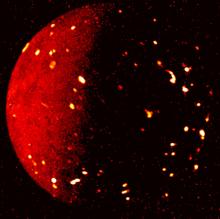Listen to today's episode of StarDate on the web the same day it airs in high-quality streaming audio without any extra ads or announcements. Choose a $8 one-month pass, or listen every day for a year for just $30.
You are here
Moon and Jupiter
Every spacecraft that visits one of the planets reveals new details about its target world. Juno, for example, is telling scientists that the interior of Jupiter is quite different from what they expected.
Juno arrived at Jupiter almost two years ago. It’s the ninth spacecraft to visit the planet, and the second to orbit it.
The craft has snapped some great pictures of Jupiter. But its main goal is to study what’s far below the planet’s surface. It’s doing so by measuring Jupiter’s gravitational and magnetic fields. That should help scientists piece together a picture of Jupiter’s insides — especially its core.
Most models of Jupiter say the core is a ball of rock and metal up to about 10 times as heavy as Earth. Other models say there’s no need for a solid core at all. Which model is right can reveal how Jupiter took shape.
But Juno’s early observations say that all the models are off — the core may be bigger and fuzzier than expected. It could be up to a couple of dozen times Earth’s mass. And it could be dissolving in the layer of metallic hydrogen around the core. If so, then the core could take up a third to a half of Jupiter’s diameter, making it far bigger than anticipated.
Each orbit around Jupiter helps Juno provide a sharper picture of the interior of the solar system’s largest planet.
And Jupiter is putting in a good appearance tonight. It rises below the Moon before midnight, and looks like a brilliant star.
Script by Damond Benningfield






